
views
Citing a Personal Interview
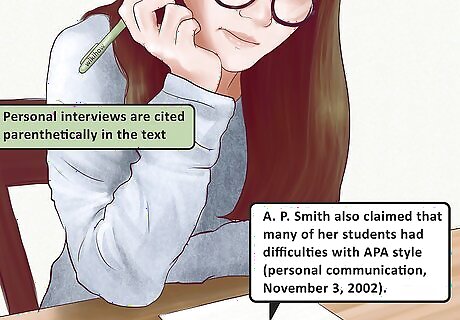
Establish if the interview counts as a ‘personal communication.’ If you conducted the interview, it is considered ‘personal.’ If another person created the interview and published it for general use, it is considered ‘published.’ Personal interviews are cited parenthetically (or internally) in the text, but not included in your works cited or reference list. This status of ‘personal communication’ also applies to other documents that are ‘not findable’ to other people, such as a private emails. For personal interviews, you may also want to include a transcript of your typed questions and answers. This should be included in an Appendix, immediately following your References page.
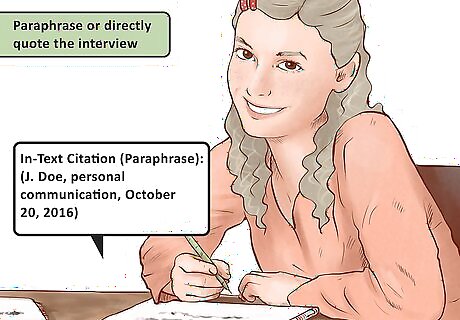
Paraphrase or directly quote the interview. Use the information as you normally would while writing. However, know that you must include an internal citation if you mention anything beyond ‘common knowledge’ that is part of the interview. The internal citation format looks the same whether you quote or paraphrase. It does not change. For example, say you write, “The people in the command room cheered after the event.” If you know this because your interview subject told you so, and this information is not readily available via a textbook, etc., then you must cite it. Failure to do so counts as academic dishonesty.
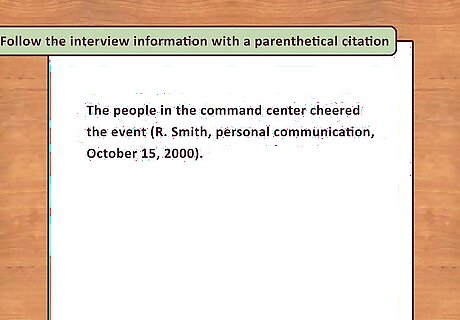
Follow the interview information with a parenthetical citation. Immediately after the sentence in which you paraphrased or quoted the interview, include a parenthetical citation, essentially a full citation contained with parentheses. You should place the previous sentence’s period after your citation. For example, in the text you will see, “The people in the command center cheered the event (R. Smith, personal communication, October 15, 2000).” Your citation counts as a continuation of that sentence for reference purposes.

Begin with the name of the interview subject. Include their first initial followed by a period, add a space, and follow it with their full last name. The initial and last name should be capitalized. Place a comma after their complete name. In the case of research interviews, your subjects may need to remain anonymous. Therefore, their full names cannot appear within your citation. Instead, if you have numerous interview participants to keep track of, you can assign them codes, such as “Male participant 23,” or “Participant 23.” The code name will then take the place of the traditional name in the internal citation. For example, your citation will look like, “(Participant 23, personal communication, October 15, 2000)."

Add the phrase, “personal communication.” Insert a single space after the comma and the phrase should appear immediately thereafter. It should be kept in all lower-case letters. Follow it with a period and another space. This phrase cannot be abbreviated, so make sure to present it consistently every time in internal citations.

Finish with the date of the interview. Take a space after the previous comma. Write out the month in full followed by the numerical day. A comma should be placed after the day number, add another space, and include the numerical year in four-digit format. For example, a date should appear as, “October 15, 2000,” not, “Oct. ’00,” or, “October 15.”
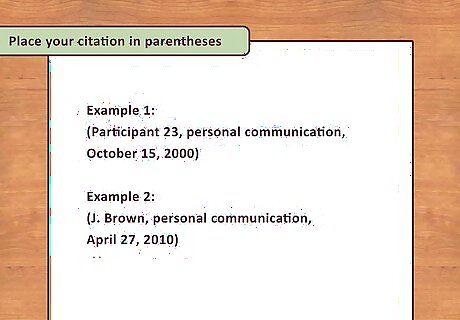
Place your citation in parentheses. The parentheses should open at the start of the citation (place it right before the author’s first initial) and close at the end of your citation (place it right after the year date). Remember to place the sentence’s period after your closed parentheses.
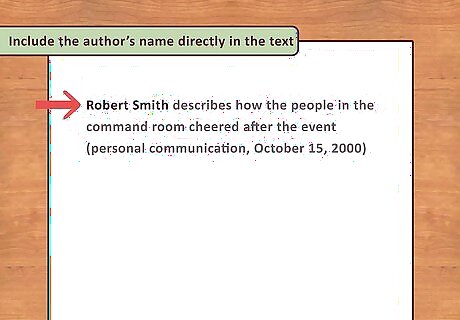
Include the author’s name directly in the text. You may end up stating the interviewee’s name in the text, in the area directly preceding the citation. If that is the case, you can go with a somewhat pared down version of your internal citation. Simply remove the author’s name from within the parentheses and cite as you normally would. This is done because it is understood that the reader can get the interview subject’s name from the preceding sentence. Otherwise, listing it twice that close together would bog down the text. You might write, “Robert Smith describes how the people in the command room cheered after the event (personal communication, October 15, 2000).”
Citing a Published Interview

Include the interview in both your internal citations and your reference list. If the interview appeared in a magazine or other publication, then it falls under these guidelines. The reference information will now appear throughout the text (as it is used) and also at the end of your work in your reference list.
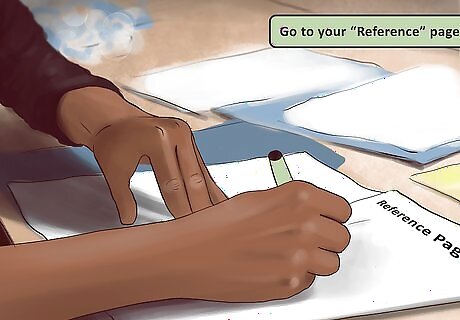
Go to your “Reference” page. This is a page at the very end of your work that lists the accumulated sources from throughout your paper. It should be organized alphabetically, so that readers can find citation information quickly.
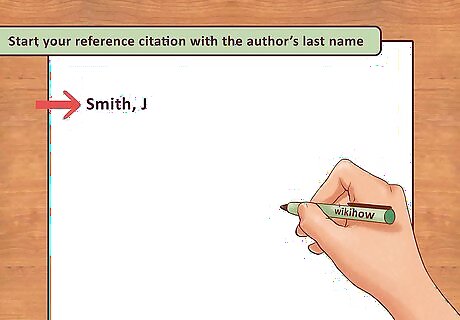
Start your reference citation with the author’s last name. Follow this with a comma and a single space. Then, include your your author’s first initial, capitalized, and followed immediately by a period and another space.
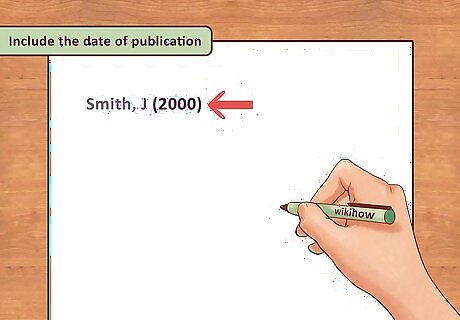
Include the date of publication. Follow the name with the four-digit date of publication in parentheses. Place a period immediate after the closed parentheses and add another space. Your date should look like, “(2000),” not, “(’00).” If you cannot find a date for the work substitute “n.d.” without quotation marks in its place.
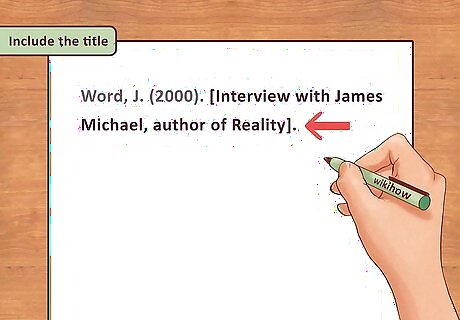
Include the title. Follow the date with the full interview title. If the interview is not titled, then include a single line description. This description should be contained within square brackets. It will often include the phrase “Interview with” followed by the interviewee’s full name, followed by a comma, and a few words of bio information. If you use brackets, add a period immediately after the closed bracket. For example, it will look like, “[Interview with James Michael, author of Reality].” Or, it could look like, “The Most Amazing Interview Title.” If you include a published work in the brief bio description, make sure to italicize the title. Include the title exactly as it appears within the published text.
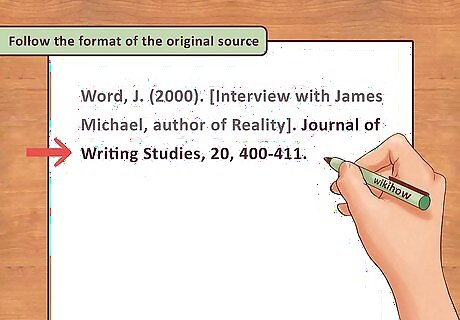
Follow the format of the original source. At this point your entry may look different depending on the original publication style. If you are working with a journal entry with a single-author, then you will want to follow that general citation style. That will determine what additional information you include in the citation. For example, when working with a single-author journal entry your citation will proceed with the full journal title, the volume number, and the page numbers of the interview. It will look similar to, “Word, J. (2000). [Interview with James Michael, author of Reality]. Journal of Writing Studies, 20, 400-411.” Note that the journal title is italicized as well. If the volume number is not available, it can be omitted. Note that the consecutive page numbers are separated with a dash. To include a series of non-consecutive page numbers you would list them with commas in between. Always end your citation with a period.

Follow with a DOI, if available. The DOI, or Digital Object Identifier, is new to the 6th edition of the APA Citation Manual. It allows an interested party to trace the source digitally. You will find the DOI in a database record for a digital magazine or perhaps at the top of a downloaded pdf. Include the DOI directly after the page numbers. For example, a DOI reference citation for a published interview might look like,”Word, J. (2000). [Interview with James Michael, author of Reality]. Journal of Writing Studies, 20, 400-411. doi:453432342342.”
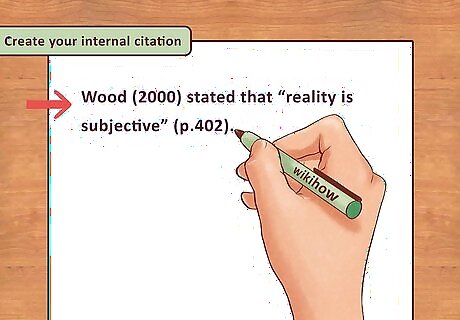
Create your internal citation. As the full information is included in the reference list, you are free to use an abbreviated in-text citation style. Immediately after a paraphrase, include the last name of the author followed by a comma and the publication year. All placed within parentheses. If you quote the published interview directly, then you must include a page number as part of your internal citation. Add a comma after the publication date and write the page number out preceded by a “p.” An in-text citation in this situation should look like, “(Wood, 2000, p. 402).” "Wood" is the author's last name, "2000" is the publication year, and "p.402" means the quotation was found on page 402 in the text. In contrast, if you mention the author directly in the text, you can follow a distinct in-text citation style. With this format you include the publication date in parentheses immediately after your mention of the author's last name and add the page numbers at the end of the sentence in parentheses as well. For example, “Wood (2000) stated that “reality is subjective” (p.402).” By looking at this sentence you can tell that the author's last name is Wood, the work was published in the year 2000, and the quote can be found on page 402 in the text. This is a good approach if you are looking to avoid heavy citing.
Citing an Interview on Audio File
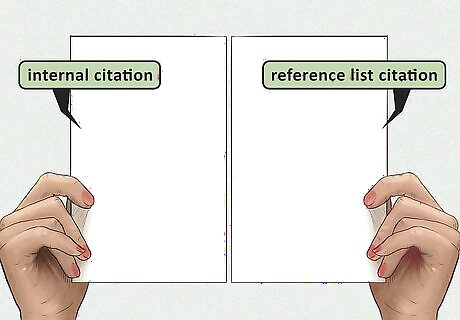
Create both an internal citation and a reference list citation. Since this is a traceable source you will want to double-up the citations the same way you did for the published interviews. You will need to include an alphabetized entry in your reference list. You will want to follow the rules when citing internally as well.
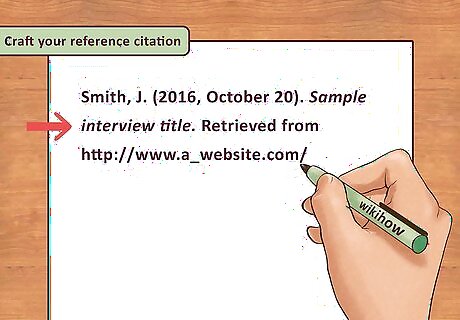
Craft your reference citation. Begin with the last name of the interviewee (the person being interviewed), followed by a comma and their first initial, followed by a period. Place the date in parentheses. The four-digit year should come first, followed by a comma, then the full month day and numerical day. Follow the date with the interview title, if available. The title should be in italics. Then, in parentheses, state the interviewer’s first initial and last name, followed by a comma and the label “Interviewer.” Then, in brackets, write out “Audio file. Close the brackets and add a period. If your audio file came from a website, at the end of your citation write, “Retrieved from,” followed by the website. Or, you can include the DOI here, if available.

Follow standard internal citation rules. When you add an internal citation for an audio file interview, you will include the same information as with a published source, minus the page numbers unless you are working from a transcript. You will use the interviewee last name followed by a comma and the date, all in brackets.




















Comments
0 comment